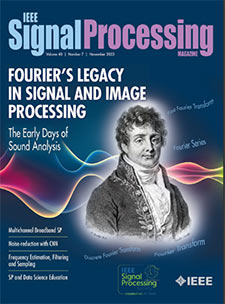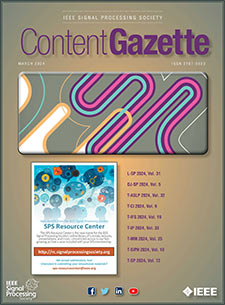- Our Story
- Publications & Resources
- Publications & Resources
- Publications
- IEEE Signal Processing Magazine
- IEEE Journal of Selected Topics in Signal Processing
- IEEE Signal Processing Letters
- IEEE/ACM Transactions on Audio Speech and Language Processing
- IEEE Transactions on Computational Imaging
- IEEE Transactions on Image Processing
- IEEE Transactions on Information Forensics and Security
- IEEE Transactions on Multimedia
- IEEE Transactions on Signal and Information Processing over Networks
- IEEE Transactions on Signal Processing
- IEEE TCI
- IEEE TSIPN
- Data & Challenges
- Submit Manuscript
- Guidelines
- Information for Authors
- Special Issue Deadlines
- Overview Articles
- Top Accessed Articles
- SPS Newsletter
- SigPort
- SPS Resource Center
- Publications Feedback
- Publications FAQ
- Blog
- News
- Dataset Papers
- Conferences & Events
- Community & Involvement
- Professional Development
- For Volunteers
- Information for Authors-OJSP
-
Home
Conferences14 April 2025 to 17 April 2025Conferences Events IEEE JSTSP Article IEEE Signal Processing Magazine IEEE TIFS Article IEEE TMM Article IEEE TSP Article Jobs in Signal Processing Lectures Machine Learning Seasonal Schools Signal Processing News SPM Article SPS Distinguished Lectures SPS Newsletter Article SPS Webinar SPS Webinars SPS Webinar Series Webinar webinars
-
Our Story
What is Signal Processing?

The technology we use, and even rely on, in our everyday lives –computers, radios, video, cell phones – is enabled by signal processing. Learn More » -
Publications & Resources
-
SPS Resources
- Signal Processing Magazine The premier publication of the society.
- SPS Newsletter Monthly updates in Signal Processing
- SPS Resource Center Online library of tutorials, lectures, and presentations.
- SigPort Online repository for reports, papers, and more.
- SPS Feed The latest news, events, and more from the world of Signal Processing.
-
SPS Resources
-
Conferences & Events
-
Community & Involvement
-
Membership
- Join SPS The IEEE Signal Processing Magazine, Conference, Discounts, Awards, Collaborations, and more!
- Chapter Locator Find your local chapter and connect with fellow industry professionals, academics and students
- Women in Signal Processing Networking and engagement opportunities for women across signal processing disciplines
- Students Scholarships, conference discounts, travel grants, SP Cup, VIP Cup, 5-MICC
- Young Professionals Career development opportunities, networking
- Get Involved
-
Technical Committees
- Applied Signal Processing Systems
- Audio and Acoustic Signal Processing
- Bio Imaging and Signal Processing
- Computational Imaging
- Image Video and Multidimensional Signal Processing
- Information Forensics and Security
- Machine Learning for Signal Processing
- Multimedia Signal Processing
- Sensor Array and Multichannel
- Signal Processing for Communication and Networking
- Signal Processing Theory and Methods
- Speech and Language Processing
- Technical Working Groups
- More TC Resources
-
Membership
-
Professional Development
-
Professional Development
- Mentoring Experiences for Underrepresented Young Researchers (ME-UYR)
- Micro Mentoring Experience Program (MiME)
- Distinguished Lecturer Program
- Distinguished Lecturers
- Distinguished Lecturer Nominations
- Past Lecturers
- Distinguished Industry Speaker Program
- Distinguished Industry Speakers
- Distinguished Industry Speaker Nominations
- Industry Resources
- IEEE Training Materials
- Jobs in Signal Processing: IEEE Job Site
-
Career Resources
- SPS Education Program Educational content in signal processing and related fields.
- Distinguished Lecturer Program Chapters have access to educators and authors in the fields of Signal Processing
- PROGRESS Initiative Promoting diversity in the field of signal processing.
- Job Opportunities Signal Processing and Technical Committee specific job opportunities
- Job Submission Form Employers may submit opportunities in the area of Signal Processing.
-
Professional Development
-
For Volunteers
-
For Board & Committee Members
- Board Agenda/Minutes* Agendas, minutes and supporting documentation for Board and Committee Members
- SPS Directory* Directory of volunteers, society and division directory for Board and Committee Members.
- Membership Development Reports* Insight into the Society’s month-over-month and year-over-year growths and declines for Board and Committee Members
-
For Board & Committee Members
Popular Pages
Today's:
- Submit a Manuscript
- Information for Authors
- (MLSP 2024) 2024 IEEE International Workshop on Machine Learning for Signal Processing
- IEEE/ACM Transactions on Audio Speech and Language Processing
- SPS Scholarship Program
- IEEE Transactions on Multimedia
- IEEE Transactions on Image Processing
- (SLT 2024) 2024 IEEE Spoken Language Technology Workshop
- Conferences & Events
- (ACSSC 2024) 2024 Asilomar Conference on Signals, Systems, and Computers
- (ICASSP 2024) 2024 IEEE International Conference on Acoustics, Speech and Signal Processing
- IEEE Transactions on Information Forensics and Security
- Information for Authors-SPL
- IEEE Signal Processing Letters
- SPS SA-TWG Webinar: Maximum a Posteriori Penalty Function (MAP-PF) Multitarget Tracking
All time:
- Information for Authors
- Submit a Manuscript
- IEEE Transactions on Image Processing
- 404 Page
- IEEE/ACM Transactions on Audio Speech and Language Processing
- IEEE Transactions on Information Forensics and Security
- IEEE Transactions on Multimedia
- IEEE Signal Processing Letters
- IEEE Transactions on Signal Processing
- Conferences & Events
- IEEE Journal of Selected Topics in Signal Processing
- Information for Authors-SPL
- Conference Call for Papers
- Signal Processing 101
- IEEE Signal Processing Magazine
Last viewed:
- Data Science Initiative
- Submit a Manuscript
- SPS Scholarship Program
- SPS SLTC/AASP TC Webinar: End-to-End Automatic Speech Recognition
- (SLT 2024) 2024 IEEE Spoken Language Technology Workshop
- SPS SLTC/AASP TC Webinar: Nonnegative Autoencoders with Applications to Music Audio Decomposing
- Guidelines
- (SPAWC 2024) 2024 IEEE 25th International Workshop on Signal Processing Advances in Wireless Communications
- SPS SLTC/AASP TC Webinar: Diffusion Models for Speech Enhancement and Restoration
- AASP TC Webinars
- Editorial Board
- IVMSP TC Home
- IEEE Signal Processing Magazine
- Publications & Resources
- Editorial Board
Recent Patents in Signal Processing (September 2015) – Resource Management
You are here
Newsletter Menu
Newsletter Categories
Top Reasons to Join SPS Today!
1. IEEE Signal Processing Magazine
2. Signal Processing Digital Library*
3. Inside Signal Processing Newsletter
4. SPS Resource Center
5. Career advancement & recognition
6. Discounts on conferences and publications
7. Professional networking
8. Communities for students, young professionals, and women
9. Volunteer opportunities
10. Coming soon! PDH/CEU credits
Click here to learn more.
News and Resources for Members of the IEEE Signal Processing Society
Recent Patents in Signal Processing (September 2015) – Resource Management
For our September 2015 issue, we cover recent patents granted in the area of Resource Management. The section below covers patents granted recently for various forecasting, modeling and evaluation solutions approached via resource management.
In patent no. 9,117,172 methods and computer implemented systems for evaluation and optimisation of methods used for forecasting, modeling, valuation, and decision-making, in staged resource planning are provided. Fundamentally, a universal comparator that accounts for perfect decision differencing (PERNOB) is determined and used for evaluating benefits associated with the use of prediction method-sets and decision-making method-sets in staged resource planning. According to one application, PERNOB is used to evaluate different prediction method-sets and decision-making method-sets and enable the selection of optimal method-sets corresponding to a given situation. According to another application, PERNOB is used to create an unbiased operational decision making environment through realistic re-valuation of system resource(s).
In patent no. 9,117,054 methods and apparatus provide resource authorization based on a computer's presence information. Presence information may include information relating to a computer's operating environment. In some implementations, a presence detector on a computer determines presence information and provides the information to a resource manager. The computer may then generate a resource access request. A resource manager may then determine whether the resource request is authorized based, at least in part, on the presence information. The resource manager then responds to the resource access request, either granting or denying the request for resources.
A system and method in the invention no. 9,116,744 manages resources within a process by identifying a first resource threshold associated with available resources. The method receives a resource request from a resource requesting participant requiring the available resources. The method determines that an estimated resource usage, associated with the resource request, approaches the first resource threshold. The method negotiates with at least one resource consuming participant to voluntarily release resources until the estimated resource usage approaches a second resource threshold associated with the available resources within the process.
Certain aspects of the disclosure in patent no. 9,113,463 provide techniques for managing resources utilized for enhanced physical downlink control channel (PDCCH) transmissions. According to certain aspects, a method is provided for wireless communications which may be performed, for example, by a user equipment (UE). The method generally includes receiving signaling indicating a set of time and frequency resources in one or more subframes allocated for an enhanced physical downlink control channel (PDCCH), receiving a downlink transmission in a subframe, making a determination to monitor for the enhanced PDCCH in the subframe based on the signaling, and decoding the enhanced PDCCH transmitted using the set of time and frequency resources in the subframe, in response to the determination.
As detailed in patent no. 9,106,591, allocation of resources across multiple consumers allows efficient utilization of shared resources. Observed usages of resources by consumers over time intervals are used to determine a total throughput of resources by the consumers. The total throughput of resources is used to determine allocation of resources for a subsequent time interval. The consumers are associated with priorities used to determine their allocations. Minimum and maximum resource guarantees may be associated with consumers. The resource allocation aims to allocate resources based on the priorities of the consumers while aiming to avoid starvation by any consumer. The resource allocation allows efficient usage of network resources in a database storage system storing multiple virtual databases.
In patent no. 9,100,836 there is provided a solution for reusing radio resources opportunistically by private base stations to increase the overall capacity of the network. The solution is based on applying an uplink broadcast in a mobile communication, in which information representing a radio resource allocated by a base station to a user terminal is broadcasted.
In patent no. 9,100,304 a system comprises a communications network configured to support transmission of a plurality of communications streams and a resource manager communicatively coupled to the communications network and configured to provision resources of the communications network to the plurality of communications streams. The system may further comprise a performance test manager communicatively coupled to said communications network and configured to identify a communication stream from said plurality of communications streams, identify a test network path for said identified communication stream that is substantially free of other network traffic, and perform a performance test over said test network path.
An architecture for multi-core and many-core processor systems from patent no. 9,098,726 includes a set of resource managers having a hierarchy of at least one level. The resource managers act as trusted proxies for the operating system (OS) kernel to manage resources for applications. The application may include a trusted secure specification defining resource and access privileges of the associated application.
According to exemplary embodiments no 9,094,872. , a method for resource management of network systems includes sampling channel states of a first set of channels from at least one base station associated with a radio network controller providing an application and estimating channel states of a second set of channels from the at least one base station, wherein the estimated channel states are based on previously sampled channel states and currently sampled channel states. The method further includes adapting at least one runtime parameter of the application based on the sampled channel states of the first set of channels and the estimated channel states of the second set of channels.
If you have an interesting patent to share when we next feature patents related to resource management, or if you are especially interested in a signal processing research field that you would want to be highlighted in this section, please send email to Csaba Benedek (benedek.csaba AT sztaki DOT mta DOT hu).
References
Number: 9,117,172
Title: Optimisation of resource management using perfect knowledge bias
Inventors: K. Reznichek and J.Q. Snell
Issued: August 25, 2015
Assignee: Manitoba Hydro (Winnipeg, Manitoba, CA)
Number: 9,117,054
Title: Method and aparatus for presence based resource management
Inventors: R.B. Black
Issued: August 25, 2015
Assignee: Websense, Inc. (San Diego, CA)
Number: 9,116,744
Title: Resource management within a process via iterative negotiation
Inventors: P.R. Koza
Issued: August 25, 2015
Assignee: International Business Machines Corporation (Armonk, NY)
Number: 9,113,463
Title: Resource management for enhanced PDCCH
Inventors: W. Chen, P. Gaal, T. Luo, J. Damnjanovic and S. Geirhofer
Issued: August 18, 2015
Assignee: QUALCOMM Incorporated (San Diego, CA)
Number: 9,106,591
Title: Adaptive resource management using survival minimum resources for low priority consumers
Inventors: B. Klots, S. Sinha, K. Subhadeep and S. Kumar
Issued: August 11, 2015
Assignee: Delphix Corporation (Menlo Park, CA)
Number: 9,100,836
Title: Radio resource management in mobile communication network employing private base stations
Inventors: M.E. Khan, M. Latva-Aho and Matti
Issued: August 4, 2015
Assignee: Nokia Solutions and Networks Oy (Espoo, FI)
Number: 9,100,304
Title: Resource management in dynamic network environments
Inventors: H. Omar
Issued: August 4, 2015
Assignee: Verizon Patent and Licensing Inc. (Basking Ridge, NJ)
Number: 9,098,726
Title: Scalable and secure application resource management and access control for multicore operating systems
Inventors: D. Waddington, C. Tian
Issued: August 4, 2015
Assignee: Samsung Electronics Co., Ltd. (Suwon-si, KR)
Number: 9,094,872
Title: Enhanced resource management for a network system
Inventors: D. Agrawal, T. He, R. Raghavendra
Issued: July 28, 2015
Assignee: International Business Machines Corporation (Armonk, NY)
Open Calls
Research Opportunities
News & Announcements
- Signal Processing Conferences
- Call for Participation: IEEE Signal Processing Cup 2016
- Obituary for James L. Flanagan
- Call for Papers: ICASSP 2016
- IEEE-USA offers free e-books to members in August and September
- Get involved in IEEE Future Directions initiatives; contribute IoT use case scenarios
- 2015 Member-Driven Initiatives – Funding Available
- vTools release announcement: Usability and interface enhancements
- Request for proposals: Humanitarian projects: deadline 30 September
- Geographic unit website feature: Automatic feed of officers and events available
- IEEE in 2030 Challenge seeks proposals for innovative projects: Deadline extended to 15 September
- Member Discounts: International travel guide for members in Regions 8-10
- IEEE Women in Engineering news: Live chat series, 2016 leadership conference, virtual career fair, awards program, summits
- New SPS Chapters
- Use vTools.Voting for your upcoming unit elections
- Updated call for participation: 2015 Volunteer Leadership Training Program (VOLT): Deadlines 24 August and 4 September
- Last call for applications: IEEE Smart Cities Initiative: Deadline extended to 31 August
Member Highlights
Publications News
Society News
Initiatives & Trends
Education & Resources
PhD Theses
Chapter & DL News
SPS on Twitter
- DEADLINE EXTENDED: The 2023 IEEE International Workshop on Machine Learning for Signal Processing is now accepting… https://t.co/NLH2u19a3y
- ONE MONTH OUT! We are celebrating the inaugural SPS Day on 2 June, honoring the date the Society was established in… https://t.co/V6Z3wKGK1O
- The new SPS Scholarship Program welcomes applications from students interested in pursuing signal processing educat… https://t.co/0aYPMDSWDj
- CALL FOR PAPERS: The IEEE Journal of Selected Topics in Signal Processing is now seeking submissions for a Special… https://t.co/NPCGrSjQbh
- Test your knowledge of signal processing history with our April trivia! Our 75th anniversary celebration continues:… https://t.co/4xal7voFER
Home | Sitemap | Contact | Accessibility | Nondiscrimination Policy | IEEE Ethics Reporting | IEEE Privacy Policy | Terms | Feedback
© Copyright 2024 IEEE – All rights reserved. Use of this website signifies your agreement to the IEEE Terms and Conditions.
A not-for-profit organization, IEEE is the world's largest technical professional organization dedicated to advancing technology for the benefit of humanity.







